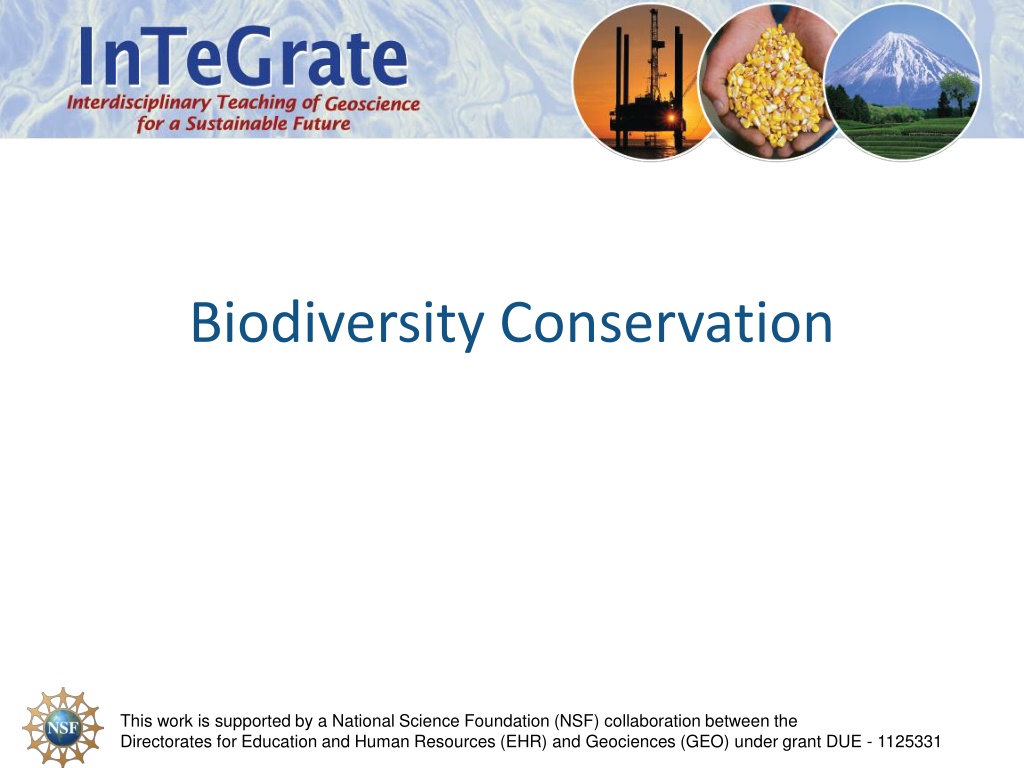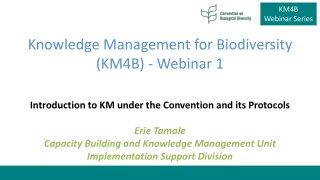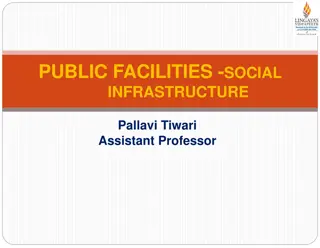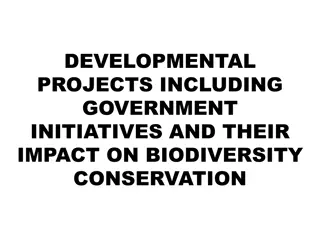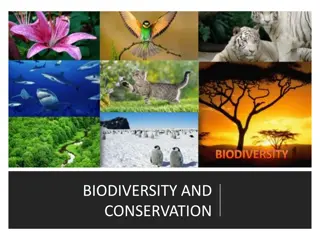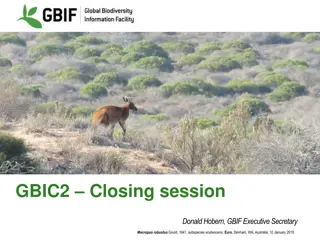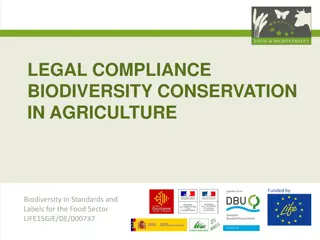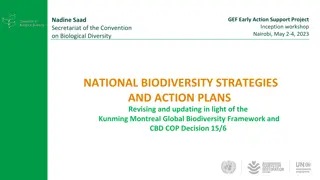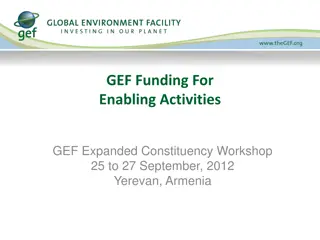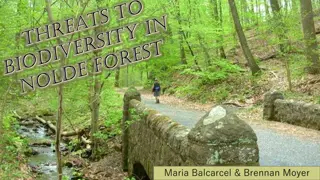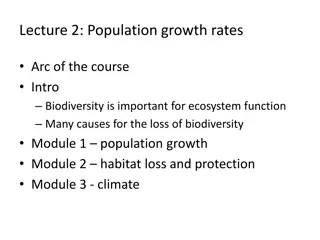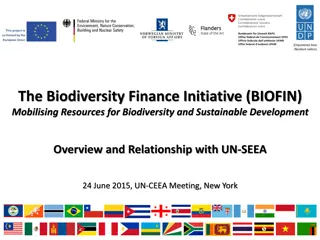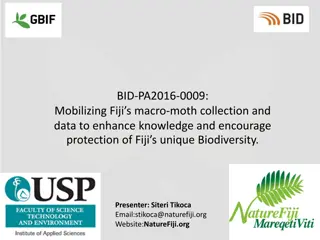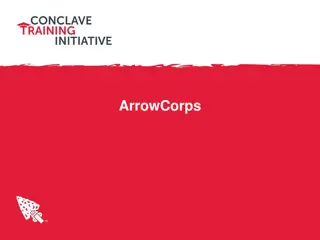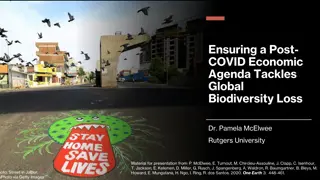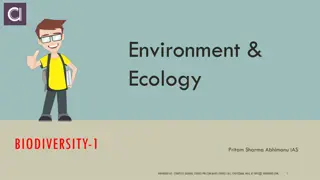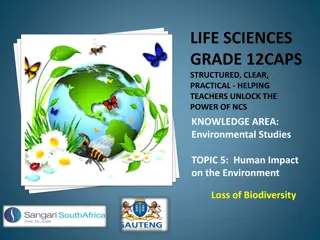Understanding Biodiversity Conservation and Its Importance
Exploring the concept of biodiversity conservation supported by the National Science Foundation, this work delves into the impacts of human activities on biological diversity, compares current extinction rates with past events, evaluates species conservation priorities, and distinguishes between ex situ and in situ conservation approaches. The reasons for conserving biodiversity, including biological resources, ecosystem services, and social/spiritual benefits, are highlighted. The discussion also covers ex situ conservation methods such as zoos and gene banks, with examples like the successful reintroduction of Przewalski's horses through captive breeding programs.
- Biodiversity conservation
- Conservation strategies
- Extinction rates
- Ecosystem services
- Species preservation
Download Presentation

Please find below an Image/Link to download the presentation.
The content on the website is provided AS IS for your information and personal use only. It may not be sold, licensed, or shared on other websites without obtaining consent from the author. Download presentation by click this link. If you encounter any issues during the download, it is possible that the publisher has removed the file from their server.
E N D
Presentation Transcript
Biodiversity Conservation This work is supported by a National Science Foundation (NSF) collaboration between the Directorates for Education and Human Resources (EHR) and Geociences (GEO) under grant DUE - 1125331
In this activity, you will explore the current Sixth Extinction and biodiversity conservation. By the end, you should be able to: 1. Explain the impacts of humans on biological diversity. 2. Compare and contrast the causes and rates of the sixth extinction with previous mass extinctions from the fossil record. 3. Evaluate criteria for setting species conservation priorities. 4. Distinguish between ex situ and in situ conservation approaches.
What is Biodiversity Conservation? Maintaining the diversity of species, habitats, and the interrelationships between organisms and the environment to keep ecosystems healthy and functioning.
Why Should We Conserve Biodiversity? Biological Resources Food, fibers, medicine, wood products, etc. Ecosystem Services Decomposition of waste, pollination, water purification, flood control, increased soil fertility, etc. Social & Spiritual Benefits Cultural and aesthetic value, recreation & tourism, etc.
How: Ex Situ or In Situ Conservation? Ex situ: Conservation of the components of biological diversity off-site, or outside their natural surroundings. In situ: Conservation of species, habitats, or ecosystems on-site, or in their natural surroundings
Ex situ conservation Zoos, botanical gardens, aquaria Storage of tissues, seeds, pollen, semen, ovules, embryos, microbial cultures, DNA Field gene banks or livestock parks, if materials cannot be dried or frozen Beans at the CIAT gene bank in Colombia. Photo by Neil Palmer (CIAT)
Ex situ conservation Provides insurance policy and can play important role in recovery programs. Example: Przewalski s horse, native to the steppes of Asia, went extinct in the wild ~1966. Captive breeding of 13 individuals in zoos allowed the population to rebound to >1,500 individuals and successful reintroduction in Mongolia. Photo of Przewalski s horse at Hustai National Park, Mongolia by Chinneeb.
In situ conservation Nature reserves National parks Wildlife refuges Habitat management Habitat restoration Bison at Fort Niobrara National Wildlife Refuge, Nebraska, USA. Photo by Ben Edwards, U.S. Fish and Wildlife Service Headquarters
Setting Priorities for Biodiversity Conservation It is impossible to actively conserve all species because of limited time and money. As a result, humans must make decisions about how to target conservation efforts so limited resources can have the greatest impact. So, how do we decide?
Setting Priorities Iconic or ambassador species (flagship species) Examples: Giant pandas, tigers, whales Large, land-demanding species (umbrella species) Often large carnivores or migratory species Ecologically important species (keystone species and ecosystem engineers) Examples: Wolves, beavers, elephants Economic value/ecosystem goods or services Examples: honey bees, wetlands that filter water
Setting Priorities Biodiversity How many species are in the region? Endemism or distinctiveness Are there rare or endemic species in the area? Is it a unique habitat? Is it in country with few other reserves? Extinction risk How threatened is the species or habitat? (Least Concern, Near Threatened, Vulnerable, Endangered, Critically Endangered, Extinct in Wild)
Setting Priorities Likelihood intervention will be successful Relative cost of conserving the particular species or habitat Cultural/aesthetic/recreational value Expected future changes to threats Will the proposed area still support the species of concern if climate changes or human impacts in surrounding areas increase?
Evaluating Criteria Think about the criteria for 1-2 minutes. Write down the five criteria you think are most important for deciding which species or habitats to conserve.
Evaluating Criteria Form groups of 3-4 and share ideas. As a group, choose your top three priorities and write a short justification for each. Be prepared to share these with the class in ~5 minutes.
Applying Criteria You are members of Conservation World, a large international organization that funds conservation projects. Your task is to evaluate the potential projects in your packet. Resources are limited, so you must choose one that you will recommend to the board of directors for funding. You must include a justification for your recommendation. You will make your recommendation to the Board (class) in 15 minutes.
References Maxted, N. 2001. Ex situ, in situ conservation. Encyclopedia of Biodiversity, Volume 2. https://enviro.doe.gov.my/lib/digital/1385455130-3-s2.0- B0122268652001152-main.pdf Slide 4. Creative Commons Image by Neil Palmer (CIAT) (NP_Genebank2011_1) [CC BY-SA 2.0 (http://creativecommons.org/licenses/by-sa/2.0)], via Wikimedia Commons Slide 5. Creative Commons Image by Chinneeb (Own work) [CC BY-SA 3.0 (http://creativecommons.org/licenses/by-sa/3.0) or GFDL (http://www.gnu.org/copyleft/fdl.html)], via Wikimedia Commons Slide 6. Creative Commons Image by U.S. Fish and Wildlife Service Headquarters [CC BY 2.0 (http://creativecommons.org/licenses/by/2.0)], via Wikimedia Commons
